Economic theory of museums
The economic theory of museums is a field of cultural economics that focuses on the economic functioning of museums.
More specifically, the economic theory of museums mainly analyzes museum activity within two frameworks.[1] Firstly, a museum can be considered as an economic unit (like a business), viewed from the angle of the relationship between its inputs (collections, budget, employees) and its output (sales, exhibitions, media presence, scientific publications). Within this framework, the effect of museums on other sectors can also be studied in terms of employment or sales generated. Secondly, it can be studied as a neoclassical economic[nb 1][nb 1] agent maximizing an objective under a constraint of allocation of scarce resources (what can be done with the means provided?).
The economic analysis of museums highlights the fundamental impact of financing methods (subsidies, own resources, donations) on museum policy in terms of collection management, artistic orientation (towards the general public or connoisseurs) and the implementation of activities designed to increase resources.
Since the 1980s, the number of museums[2] has risen sharply, and a star system[3] has emerged for museums located in touristic destinations, housed in spectacular buildings and boasting world-famous works in their collections. These museums are attracting a growing share of visitors, while other museums, though increasingly numerous, are seeing their attendance decline.[3]
Like the rest of cultural economics, the economic theory of museums is a relatively recent branch of economics. In fact, economic analysis only began to be applied to museums in the 1980s, as the number of museums multiplied and trade-offs were made necessary by the climate of budgetary austerity that called into question public subsidies in all fields, and particularly in culture.
Delimitation
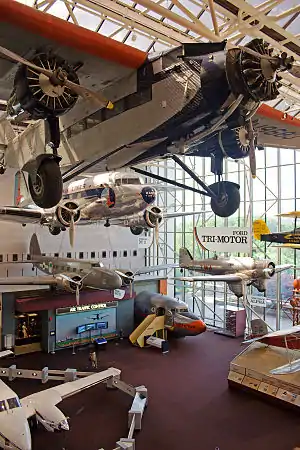
The literature on the economics of museums dates back to the 1980s, when they began to proliferate, and their budgets were squeezed by the economic crisis.[4] Until the early 19th century, museums were only open to apprentice artists who came to imitate established works. Even if, from 1880 onwards, they also began to take on an educational mission, the opening up to a wider public was slow in coming, and was viewed with great reluctance by a profession inhabited by an elitist conception of its function.[5] As a result, the question of museum budgets remained essentially linked to their role in preserving artistic heritage, until the combination of declining public finances and rising costs (due to Baumol effect, see cost structure below) led to the re-emergence of the question of the economic justification for the existence of museums.
Despite the wide variety of types of museum (art, science and technology, ecomuseums), the issues are similar: how to reconcile preservation and educational objectives with the career goals of museum managers? During the 1990s, museums devoted to science and technology generally experienced fewer difficulties, both in terms of funding and legitimacy,[6] than art museums. It is therefore the latter that has been the focus of most of the work.
This article begins by explaining the reasons for the existence of museums: What reasons can private and public agents have for both wishing for the mere existence of museums and for visiting them? What factors influence the decision to visit museums? It then presents the specific features of the current museum offer, firstly from the point of view of the costs of existing museums, in an attempt to identify what would be the production function of a museum (the relationship between its financial and human resources and the conservation, documentation and exhibition services provided), and secondly from the point of view of the number and type of existing museums. At the heart of this relationship between resources and services, two issues in particular stand out: the management of collections housed by museums, and the pricing policy applied. Finally, the article looks at the recent trend towards concentrating visits and resources on a small number of museums and exhibitions.
The demand: why go to the museum?
The main art museums in existence today are the heirs to institutions or collections dating back to the early 20th century, and in some cases much earlier. The opening of more recent museums has more to do with scientific and regional development issues than purely economic factors. For this reason, the analysis of demand for museum services starts from the situation where a museum already exists.
Demand for the services provided by a museum therefore comes both from individual agents, interested in the museum's collections and from individual or collective agents benefiting from the economic activity generated by the museum.
Private demand
The most significant in terms of volume,[7] it essentially depends on the price of the entrance ticket, the opportunity cost of time spent visiting, and the price of alternative activities.
Ticket price
.jpg.webp)
Econometric studies, most often carried out on a small number of museums, suggest that the price elasticity of admissions (the drop in admissions generated by an increase in ticket price) is very low (0 to -0.5), i.e. the number of visitors declines little when the price of admission rises.[7] This effect is particularly marked for art museums, while demand for science and history museums is more sensitive due to the greater number of competing activities nearby. The consequence of this low elasticity is that some museums can find a significant source of income in the price of admission without seeing their attendance drop significantly. However, Mr. Feldstein[8] notes that ticket prices account for only 5% of the revenue of the 150 largest museums in the United States.
As these estimates are based on price variation, assessing the impact of a switch from paid to free admission requires other tools, which are directly relevant to the pricing policy applied by museums (see below).
Visitor opportunity cost and revenue sensitivity
The question of the income sensitivity of the number of museum visits is important in a public policy framework, as it helps to determine whether museum subsidies can have a regressive effect (benefiting high-income earners more than low-income earners).
Theoretically, the effect is ambiguous. In fact, it can be assumed that income is very strongly correlated with the level of education, which is an important determinant of visitation. On the other hand, higher income implies a higher opportunity cost of time spent visiting. People with higher incomes are both more inclined to go to museums ( to the extent that they are better educated to understand what they see), and less inclined to go, as the cost to them of taking time off (as opposed to working longer hours) is higher.
The fact that income elasticity is stronger for more knowledge-intensive museums, such as contemporary art museums, argues for the idea that income acts only as a consequence of higher human capital.[6] Statically, then, income in itself is not an essential determinant of museum attendance for people with equivalent levels of education.
Dynamically, on the other hand (see below), it can seen that demand for temporary exhibitions increases with average income, and faster than the increase of that income. It can therefore be considered a luxury good, but its subsidy does not induce strong regressive effects.
Pricing of alternative or complementary activities
For visitors who don't live near a museum, the decision to visit a particular museum is based on a comparison not only of ticket prices, but also of all the costs (transport, accommodation, meals) associated with the visit, which are compared with those of alternative activities. In the case of museums in Scotland, one study[9] estimates these costs at over 80% of the total cost of the visit.
Social demand
The very existence of a museum can be the source of significant externalities, both for those whose economic activity does not depend on the existence of the museum and for those for whom it is quite directly linked. Indeed, it is considered that society as a whole benefits from the fact that certain individuals acquire a better knowledge of humanity's artistic or technical heritage. On a more concrete level, the existence of a museum generates visitor flows that benefit nearby businesses, as well as the image of the place in which they are located.
Social externalities

The case of museums is a fairly complete example of the multiple externalities of cultural goods as described by David Throsby. Non-visitors to a museum, who may not contribute to its financing, benefit from the possibility of visiting it in the future (option value), from future generations having access to these works (bequest value), from the mere existence of the objects thus preserved (existence value), from the prestige linked to the museum's existence, and from its contribution to education and the constitution of a cultural identity. These effects are notoriously difficult to estimate. Methods based on contingent valuation, on the evolution of real estate prices in the vicinity of museums, or on natural experiments on the occasion of referendums, suggest that these values are not negligible.[10]
Private externalities
These are the direct economic consequences of the existence of a museum on the profits of the agents whose activity is linked to it. As one of the foundations of the cultural multiplier, the assessment of these effects is a frequent exercise in justifying the existence of these institutions. However, they must be interpreted with caution. After all, a museum's main purpose is to preserve its collection and make it accessible to the public. Stimulation of local activity can often be achieved at a lower cost than through a museum institution.[11]
The offer: costs and organization
Cost structure

Museums have a cost structure that differs significantly from that of most companies in the service sector. Their large buildings, usually located in the heart of major conurbations, a large collection with little or no transferability, as well as insurance, security, and personnel costs, represent significant fixed costs.[11] On the contrary, the marginal cost of an additional visitor is close to zero,[nb 2] except when there is crowding around certain artworks (such as the Mona Lisa at the Louvre) or during very popular temporary exhibitions.[12] The results of an empirical study[13] on the subject confirm the existence of economies of scale below the threshold of around 100,000 visitors per year, with the average cost only increasing above this number of annual visitors. However, too few studies on the subject are available to give any real general validity to these thresholds.[14]
Moreover, like most players in the cultural sector, museums are subject to a form of Baumol effect. The cost of maintaining and preserving their heritage increases at the same rate as the wages paid to a skilled workforce. With the exception of the construction of new buildings, this problem seems to be offset in the case of museums[15] by productivity gains linked to the reduction of low-skilled jobs (camera surveillance), the dissemination of images of collections online,[nb 3] the use of volunteers and the development of derivative products based on the best-known exhibitions or works.
However, museum governance systems often separate investment decisions from those setting the operating budget. As a result, allocated budgets do not take into account the need to make provisions for major works or new buildings (the notion of accounting depreciation), and more often than not underestimate the cost of maintaining architecturally daring buildings, as well as the real cost of organizing temporary exhibitions (sometimes financed at the expense of core conservation and research activities).[2]
Opportunity costs and collection management
The most distinctive element of a museum's cost function is the potential value of its collection. A work of art in a museum's reserves represents a significant opportunity cost.[15] It could be sold to finance the museum itself or to buy other works on the market. There is therefore a trade-off between the desire to sell works to fill gaps in a museum's collection and the museum's role in preserving its heritage. To avoid placing the burden of this trade-off solely on the museum's management, most museums do not include the market value of their collections in their balance sheets, and sales of works are governed by highly restrictive statutes.[16]
The proliferation of museums

Two instruments are most often used to assess the success of museums: the total number of visitors and the ratio between the number of visits and the total population.[nb 4] According to these tools, museum attendance has increased considerably since the 1970s in developed countries. French national museums welcomed 14 million visitors (including 10 million paying visitors) in 2000,[2] while in the United States, the ratio of visits and population rose from 22.1% in 1979 to 87.3% in 1993.[2]
This increase in visitor numbers is linked to an upsurge in the number of museums on offer, as museum openings and renovations multiplied from the 1980s onwards. In Japan, three hundred new museums were opened in 15 years. Europe has witnessed an increase in exhibition space, complete reorganization, and even the opening of new facilities as part of urban renewal plans (Museum Island, Tate Modern).
Collection management
Collection origins
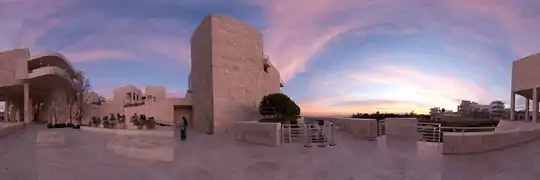
In the United States, some of the major collections, along with their buildings, initial funds and objectives, originated with a single collector (Solomon R. Guggenheim, William Wilson Corcoran, Jean Paul Getty, etc.). However, major museums (Metropolitan Museum of Art, Boston Museum of Fine Arts) are the result of large groups of individuals (a thousand donors for the Boston Museum's initial $260,000) willing to entrust financial resources and broad autonomy to a management committee. The Metropolitan, for example, took full advantage of the Franco-Prussian War of 1870 to buy old paintings at low prices. The National Gallery of Art and the Museum of Modern Art, for their part, derive from the desire of collectors (Andrew Mellon in the case of the National Gallery) to build up quality collections by aggregating private collections, and, in the case of MoMA, to use the museum to defend and illustrate the art forms they wished to promote.
The artistic or financial value attributed to a work or a movement can vary greatly over time. For example, the sale of the "pompiers" paintings, considered of no interest,[nb 5] greatly impoverished the future collections of the Musée d'Orsay.[17] As a result, curators are much more inclined to keep works in reserve which, for lack of interest and space, cannot be shown. As a result, only a small fraction of the collection is exhibited – half on average in the United States, and less than 5% (at the extreme) at the Centre Pompidou.[17]
What role can museums play?

Most museums take the form of a non-profit organization, whether operated as a foundation or as a particular type of government agency. Their objectives are therefore less clear-cut than those of a company and are subject to negotiation between stakeholders. While the initial aim of nineteenth-century museums was to replace cabinets of curiosities with systematically organized and properly documented collections,[18] today's museums seek to fulfill two contradictory roles: a didactic one and a preservation one. The didactic role is to display the most representative pieces of the various artistic movements, to show the relationships between these movements, and to enlighten the visitor with extensive documentation. The preservation role, which gives the museum a sacramental dimension,[18] emphasizes the need to preserve works of art for future generations, and to present them as they are, to encourage visitors not to see them as the product of an era, but to consider them from the point of view of pure aesthetics. The first role implies making large, well-documented exhibitions, always showing the most important and famous pieces. The need for preservation, on the other hand, encourages us to keep the most important pieces in reserve as much as possible, so as to reserve them for the work of the specialist, and to exhibit the lesser-known pieces so as to allow visitors to abstract themselves from their preconceived ideas about the type of work under consideration.
Richard Caves explains the relative dominance of the second aspect over the first, both by the training and selection of collection directors and by the ability of a conservation and exhibition policy aimed solely at connoisseurs to attract donations of important works, which are an essential element in the improvement of museum collections. Similarly, spectacular acquisitions attract not only the public, but also funds to finance building projects that are a fitting showcase for their private collections (the Guggenheim Foundation's museum series is a case in point).
However (see pricing policy below), the pressure to open up to as many people as possible, whether to attract donations or to justify themselves to the public funding, encourages directors to offer regular temporary exhibitions featuring famous works and recognized artists, in order to attract a large audience. As a result, the contrast between a permanent collection focused on showcasing rare pieces for connoisseurs, and a few particularly famous pieces, highlighted on a permanent basis (such as the Mona Lisa at the Louvre) or on a temporary basis as part of highly publicized exhibitions, is growing.
Museum budgets and management
The financing structure of museums varies widely from continent to continent, even within the largest museums. For example, 56.2% of the Louvre's 2001 budget came from subsidies, whereas in 1988, this proportion for major American museums was 33.6%, supplemented by their own revenues (18%), investment income (14.1%) and a significant proportion of private contributions (34.3%).[19]
From an institutionalist perspective,[20] the interests of museum directors need to be considered. These interests naturally include their remuneration, but also the esteem and admiration in which they are held by their reference group (art lovers and other members of their profession), their working conditions, and job security. These objectives have no a priori reason to be aligned with the objectives set for the museum they manage, whether by a foundation charter or by public authorities. As a result, differences in institutional structure can be expected to alter the constraints on museum management, leading to different behaviors in terms of collections management, visitor numbers and revenue sources.
Public museums

The finances of a public museum come almost exclusively from public subsidies, either from the State or from local authorities (60% of French museums are in this category).[5] As in most public accounting systems, any profits generated by an establishment do not belong to it, and are returned to the community budget, managers of a public museum have very little incentive to generate additional income or limit operating costs,[21] especially as D. Maddison's study[22] of a sample of British museums shows that an increase in a museum's own income almost always leads to a corresponding reduction in public subsidies. As a result, the managers of these museums are emphasizing non-commercial aspects, in terms of artistic, scientific or historical contributions.
It is therefore expected that public museums will hardly ever sell items from their collections (since they would not be able to appropriate the proceeds), that visitor numbers (or at least paid admissions) will not be an objective, resulting in a collection policy geared towards connoisseurs with minimal educational apparatus, and little attention paid to related sources of income (museum stores, museum-related restaurants). However, this theoretical prediction based on the weakness of the direct economic incentive emanating from visitors should not obscure other incentives or constraints specific to public museums. Indeed, in a financial context that encourages them to control spending, many public funders make their subsidies conditional on the pursuit of more or less formalized objectives, encouraging or forcing museums to meet the demands of visitors (current and potential) and taxpayers. For example, the Louvre, a public institution financed for the most part by the French Ministry of Culture and Communication, is bound by a performance contract requiring it to promote access for "all audiences".[23] Similarly, a local authority that funds a museum is often keen to encourage visits by school groups from its area, and to use the museum to highlight the dynamism of local cultural life in their communications.
Private museums
Private museums depend primarily on admission revenues and related income (museum shops, restaurants). In the United States, half of all museums are of this type.[2] Their objective is to maximize their revenues. This policy frequently involves resorting to the art market to sell off pieces that don't fit in with the collection and using the proceeds of such sales to buy pieces that are consistent with the installed collection. Great attention is also expected to be paid to secondary sources of income, for example through the possibility of renting out premises for non-art events. Similarly, these museums are more inclined to organize exhibitions that attract large numbers of visitors, using well-known works accompanied by a rich didactic apparatus.[24]
Non-profit organizations
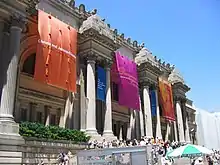
Covered by different statutes in different countries (non profit in the US, charity in the UK), these museums often benefit from measures that reduce their patrons' taxes. Their main objectives are therefore to adopt an access policy that justifies such a deduction, for example by reducing ticket prices so as not to show a profit, and a display policy that enables them to attract donations.
Donations can be both financial and charitable. In the first case, donations are matched by a display policy, with a hierarchical system of status ("donor", benefactor, etc.) and a role in the museum's policy. Donations of works of art are more complex. Museums are often obliged to accept a range of donations of heterogeneous quality, without having the option of selling or not exhibiting the least interesting pieces, which imposes very heavy costs (both direct and opportunity).[25]
Museums and art markets

Due to statutory restrictions or the fear of depriving themselves of works that could be of renewed interest, many museums refuse to sell works from their collections. Similarly, their resources only allow them to make rare (and often high-profile) purchases of recognized works, except in the case of contemporary art museums which may, as in the case of MoMA, wish to buy very recent works before the popularity of a promising artist renders his or her work inaccessible. As a result, museums have only a limited direct impact on the art market. On the other hand, they do have a strong indirect impact as a certifying authority: artists exhibited in a museum are a safe option, lowering the risk premium on their work and driving up demand and prices for their output.
For similar reasons, major museums are hostile to a price system to govern the temporary transfers of works required for thematic exhibitions. They prefer a system of mutual exchange, with the circulation of the resulting exhibition as a quid pro quo. A notable exception to this non-market system, which saves potentially heavy transaction costs, is Russian museums, whose chronic lack of funds justifies special treatment in the eyes of their colleagues.
Pricing policy

Under a certain number of visitors, the marginal cost of an additional visitor is negligible compared to the cost of preserving the collection.[26] Thus, asking each visitor to pay an amount corresponding to the average cost of the museum would exclude many potential visitors with a low willingness to pay for an additional visit. As a result, most museums have a pricing policy based on price discrimination between occasional visitors, who often have a high willingness to pay (if a visit to the museum is an essential part of a holiday in the city concerned, for example), and potentially more regular visitors, whose number of visits depends on the cost of the additional visit. In most cases, this policy takes the form of a two-part tariff structure,[26] with a single ticket on the one hand, and a subscription offering unlimited access to all or part of the museum's collections on the other.
In addition to income from admission, museums have long been dependent on either the public authorities or wealthy patrons to finance part of their operating costs. Since the mid-1980s, budgetary stringency has reduced public subsidies, while museum costs have risen as a result of both the increasing sophistication of preservation techniques and the sheer cost of building maintenance. At the same time, sponsorship is increasingly focused on operations (building construction, performances, temporary exhibitions) that provide a showcase. As a result, museums relying essentially on their own resources have increasingly turned to modest and numerous donations, in return for a policy of openness to as many people as possible.
Free access issue
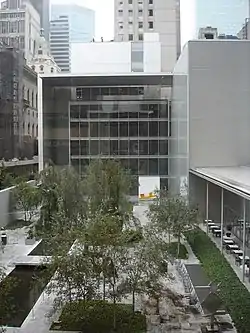
The discussion of free admission to museums goes back at least as far as Hans Sloane, whose donation in 1753 was the foundation of the British Museum. It was accompanied by the explicit condition of free access, and still is today. Similarly, the Smithsonian Institution's museums are free of charge. The essential argument in favor of free admission is that there are positive externalities associated with visiting a museum, and that visitors can therefore benefit from a subsidy offsetting all or part of the cost of their visit, the question being whether the subsidy is sufficient to fully offset the price of admission that would prevail without the subsidy.[27] John O'Hagan (1995)[28] studies the issue of free admission to national museums in Ireland, and finds that the introduction of admission charges to previously free museums does not significantly reduce attendance and, paradoxically, increases the proportion of low-income, low-education visitors.
Alternatives to free admission[nb 6] exist in the form of differentiated pricing, such as boxes with or without a suggested minimum donation, as well as unlimited access cards for a given duration. In addition, price discrimination is widely practiced:[27] museums with low or zero admission charges charge comparatively high admission fees for temporary exhibitions. Other types of discrimination are possible by varying the price according to the day of the week, the geographical origin of visitors (a discount for residents of the city or country, whose taxes help finance the museum), or even their age. Economic theory suggests that such discriminations are effective in limiting congestion and maximizing both revenue and visitor numbers.
Recent developments
Star museums
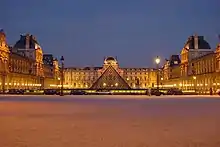
The concept of the star museum is based on the application of the superstar system[29] concept to museums: a small number of museums attract a very large share of visits. B. S. Frey and S. Meier distinguish star museums by five characteristics:[3]
- They are a "must-see" for tourists visiting the region. Examples include the Louvre, Hermitage, Prado and Rijksmuseum.
- They are very popular with visitors, and in recent years the number of visits has risen faster than that of other museums.
- Their collections include world-famous works, which are the major motivation for most visits, with visitors unaware of the composition of the rest of the collection, even though it includes other major masterpieces. The Mona Lisa, for example, attracts large numbers of visitors to the Louvre, who also see Veronese's Wedding at Cana, on display in the same room. Museums are thus known as home to these works alone, which serve to attract the public, but make prisoners of the museums, which are forced to display and showcase them to the detriment of the attention paid to the rest of their collection.
- They often have exceptional architectural settings, with recent additions by world-famous architects.
- They are commercially driven, both through the sale of merchandising products and through their major impact on the local economy.
Not all star museums meet all these criteria. For example, the Rijksmuseum does not have as exceptional an architectural setting as the Hermitage, nor any recent additions like the pyramid at the Louvre.
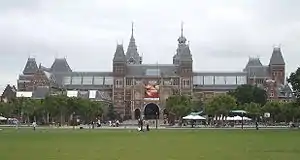
However, their status enables them to benefit from substantial scale economies in terms of media presence, and above all in the production of derivative products (virtual collections, multimedia tours, detailed catalogs of the collection or exhibitions), the cost of producing such products being essentially a fixed cost, independent of the number of customers.[30] Likewise, they represent a brand image that enables them to create branches in various locations (the Louvre Abu Dhabi, the Tate in Liverpool, while the Prado lends a third of its collections to regional museums).[30]
Star museums compete less with other local museums than with other star museums. As part of this competition, and to defend their status, they enter into a race for temporary exhibitions, spin-off activities, and spectacular buildings to reinforce their brand image. In this way, they try to make a visit a total experience, on the borderline between their traditional conservation and educational functions and a theme-park-like organization.[31]
Special exhibitions
Well-publicized temporary exhibitions are a regular feature of major museums,[31] and usually include works from other institutions. From an economic point of view, the existence and growing importance of these exhibitions pose a double problem. By mobilizing substantial resources, they stand in stark contrast to the budgetary stringency from which even the largest museums suffer, as they are forced to close entire wings from time to time. What is more, the circulation, manipulation, and exposure to large crowds of particularly fragile works seem to run counter to a museum's mission of preservation.[31] The reasons for such exhibitions are linked to differences between their demand characteristics and production conditions and those of a museum's permanent collection.
Demand for temporary exhibitions
While access to many permanent collections is free (see above), access to temporary exhibitions is generally subject to a fee. In contrast to permanent collections, the income elasticity of temporary exhibitions seems to be greater than unity.[31] The number of paying visitors to such exhibitions therefore increases mechanically with income, whereas visits to the permanent collection are more closely linked to an increase in the level of education, which is slower than that of income. As a result, the market for such exhibitions expands as income rises.
What's more, these exhibitions attract sections of the population who don't usually go to museums.[31] They reassure audiences less familiar with art, both in terms of the quality of what they are about to see (these exhibitions are reputed to be denser in terms of masterpieces than a permanent collection) and in terms of the existence of a didactic apparatus to help them understand the works on display.
These exhibitions, focusing on an author, a genre or a period, also have a greater capacity to attract the attention of art lovers outside the museum's usual area of influence.[32] Major exhibitions can be reason enough to cross the country, or even part of the continent. In terms of publicity, such exhibitions automatically generate significant media coverage. Media coverage of these exhibitions enables museums to benefit from free publicity in media such as television, which would otherwise be inaccessible to them.[32]
Moreover, the price elasticity of visitors is low. Once tourists are on site, the cost of visiting the exhibition in addition to the permanent collection is simply an additional cost,[33] and many museums offer combined tickets. Last but not least, the publicity associated with these exhibitions makes them a prime target for merchandising.[33]
Temporary exhibitions offer
From the museum's point of view, the additional cost of a temporary exhibition is low: the closure of certain rooms in order to provide the necessary staff and space is not counted as an opportunity cost, and only a few visits are lost. Similarly, delays in maintaining and cataloguing the collection are not included in the cost calculation. Mechanically, this increases the perceived profitability of such events.[33] Directors see such exhibitions as a means of generating additional resources. Yet their profitability has not been established. In France in 1992, national exhibitions generated 77.1 million francs in revenue for a cost (excluding the opportunity costs described above) of 62.6 million francs.[34]
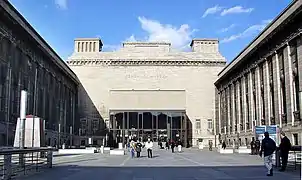
In the organization of the permanent collection, curators are bound by tradition and the need to show certain works, to the point of sometimes having a significant part of the available space occupied by irremovable pieces, either by their notoriety or by their sheer physical bulk (e.g. at the Pergamon Museum). Temporary exhibitions, whose very purpose is to highlight aesthetic links between usually separate works, provide an opportunity for a curator to demonstrate his mastery of the most artistic aspects of his work,[35] aspects that are fundamental to the advancement of his career and the recognition of his peers.
What's more, when such exhibitions are successful, the income they generate is considered exceptional and does not lead to the systematic reduction in the endowment that follows an increase in income from the permanent collection. They therefore enable the museum to capture a surplus of resources.[35] This surplus is further enhanced by the fact that media exposure makes these exhibitions prime targets for private sponsorship operations, which are assured of impact and media presence, without this sponsorship being offset by a reduction in the endowment.
The future of exhibitions
As their practices become more widespread, the true costs of temporary exhibitions are better taken into account.[36] However, their ability to attract a large number of paying visitors to the museum, as well as audiences who are usually absent from the exhibition halls, seems to be undiminished. B. S. Frey and S. Meier consider that, while the growth of such exhibitions is likely to slow down, they will in the future represent a significant part of museum activity, and a factor in the partial integration of these institutions into a market logic and openness to the greatest possible number of people.
Bibliography
- V. A. Ginsburgh, David Throsby, Handbook of the Economics of Art and Culture, vol. 1, Amsterdam/Boston Mass., North-Holland, "Handbooks" series, November 11, 2006, 1400 p. (ISBN 978-0-444-50870-6), 10: Heritage, "Chapter 29: The Economics of Museums", pp. 1018–1047
- The definitive textbook on the economics of culture. The chapter on the Economics of Museums, written by Bruno S. Frey and Stephan Meier, focuses on how institutional factors (public or private museums, for example) influence the management of these establishments (collection policy, pricing, etc.). Two trends in particular are examined: the establishment of a museum star system and the growing role of temporary exhibitions. The bibliography in this chapter explores the research literature on this subject.
- Richard Caves, Creative Industries (detail of edition), "21 Filtering and Storing Durable Creative Goods: Visual Arts", pp. 329–347
- Caves' book is to the popularization of cultural economics what the Handbook above is to research: it provides a comprehensive overview of the characteristics of the various markets for cultural goods and describes their different forms of organization. The chapter on museums focuses on the tension between the certification role of museums and the temptation for curators to anticipate fluctuations in interest in the various works in their field.
- (fr) Françoise Benhamou, L'Économie de la culture, Paris, La Découverte, coll. "Repères, 192", 2003 (repr. 4th ed.), 125 p. (ISBN 2-7071-3943-2), chap. IV ("III-2 Les marchés de l'art et du patrimoine ; Les musées"), p. 50–57
- In this section, Françoise Benhamou adopts a more descriptive perspective than in the Handbook.
References
- Victor Ginsburgh, David Throsby, , North-Holland, 2006 (ISBN 978-0444508706). p. 1019.
- Benhamou, L'Économie de la culture. p. 51.
- Victor Ginsburgh, David Throsby, , North-Holland, 2006 (ISBN 978-0444508706). p. 1036.
- Benhamou, L'Économie de la culture. p. 50.
- Benhamou, L'Économie de la culture. p. 52.
- Victor Ginsburgh, David Throsby, , North-Holland, 2006 (ISBN 978-0444508706). p. 1022.
- Victor Ginsburgh, David Throsby, Handbook of the Economics of Art and Culture, North-Holland, 2006 (ISBN 978-0444508706) p. 1021.
- Martin S. Feldstein, The Economics of Art Museums, Chicago/London, The University of Chicago Press, 1991, 374 p. (ISBN 0-226-24073-8), quoted by Benhamou, p. 57
- Bailey, Falconer, Foley and McPherson (1998), featured in Handbook, p. 1021.
- Victor Ginsburgh, David Throsby, Handbook of the Economics of Art and Culture, North-Holland, 2006 (ISBN 978-0444508706) p. 1023.
- Victor Ginsburgh, David Throsby, Handbook of the Economics of Art and Culture, North-Holland, 2006 (ISBN 978-0444508706) p. 1024.
- D. Maddison and T. Foster use a contingent valuation method for the British Museum to estimate the cost of congestion. This method leads to a cost estimate of the order of £8.05, which D. Frey and S. Meier rate as exceptionally high. Meier (Handbook, p. 1024) consider exceptionally high, like most valuations obtained by this type of method. See: D. Maddison et T. Foster, "Valuing Congestion Costs in the British Museum", Oxford Economic Papers, no 55, 2003, p. 173-190 (ISSN 0030-7653 and 1464-3812, DOI 10.1007/BF00220045, read online archive).
- R. Jackson, "A Museum Cost Function", Journal of Cultural Economics, no 12, 1988, p. 41-50 (ISSN 0885-2545), quoted by Handbook p. 1025.
- Victor Ginsburgh, David Throsby, Handbook of the Economics of Art and Culture, North-Holland, 2006 (ISBN 978-0444508706) p. 1026.
- Victor Ginsburgh, David Throsby, Handbook of the Economics of Art and Culture, North-Holland, 2006 (ISBN 978-0444508706) p. 1025.
- Richard E. Caves, Creative Industries, Contracts between arts and commerce, Harvard, Harvard University Press, 2002 (ISBN 0-6740-0808-1) p. 346
- Benhamou, L'Économie de la culture. p. 54.
- Richard E. Caves, Creative Industries, Contracts between arts and commerce, Harvard, Harvard University Press, 2002 (ISBN 0-6740-0808-1) p. 342
- Benhamou, L'Économie de la culture. p. 53.
- Victor Ginsburgh, David Throsby, Handbook of the Economics of Art and Culture, North-Holland, 2006 (ISBN 978-0444508706) p. 1029.
- Victor Ginsburgh, David Throsby, Handbook of the Economics of Art and Culture, North-Holland, 2006 (ISBN 978-0444508706) p. 1030.
- D. Maddison, "Causality and museum subsidies", Journal of Cultural Economics, no 28, 2004, p. 89-108 (read online archive, read online archive), quoted by Handbook, p. 1030.
- (fr) Farida Bréchemier/MCC, "Signature du 2e contrat de performance du musée du Louvre" archive, Ministère de la culture et de la communication, July 11th, 2006 (accessed August 7th, 2009)
- Victor Ginsburgh, David Throsby, Handbook of the Economics of Art and Culture, North-Holland, 2006 (ISBN 978-0444508706) p. 1030-1031.
- Victor Ginsburgh, David Throsby, Handbook of the Economics of Art and Culture, North-Holland, 2006 (ISBN 978-0444508706) p. 1031.
- Richard E. Caves, Creative Industries, Contracts between arts and commerce, Harvard, Harvard University Press, 2002 (ISBN 0-6740-0808-1) p. 340.
- Victor Ginsburgh, David Throsby, Handbook of the Economics of Art and Culture, North-Holland, 2006 (ISBN 978-0444508706) p. 1033.
- John W. O'Hagan, "National Museums: To Charge or Not to Charge?", Journal of Cultural Economics, vol. 19, no 1, 1995, p. 17-32 (read online archive, read online archive)
- Sherwin Rosen, "The Economics of Superstars", American Economic Review, no 71, 1981, p. 845-858
- Victor Ginsburgh, David Throsby, Handbook of the Economics of Art and Culture, North-Holland, 2006 (ISBN 978-0444508706) p. 1037.
- Victor Ginsburgh, David Throsby, Handbook of the Economics of Art and Culture, North-Holland, 2006 (ISBN 978-0444508706) p. 1038.
- Victor Ginsburgh, David Throsby, Handbook of the Economics of Art and Culture, North-Holland, 2006 (ISBN 978-0444508706) p. 1039.
- Victor Ginsburgh, David Throsby, Handbook of the Economics of Art and Culture, North-Holland, 2006 (ISBN 978-0444508706) p. 1040.
- Benhamou, L'Économie de la culture. p. 57.
- Victor Ginsburgh, David Throsby, Handbook of the Economics of Art and Culture, North-Holland, 2006 (ISBN 978-0444508706) p. 1041.
- Victor Ginsburgh, David Throsby, Handbook of the Economics of Art and Culture, North-Holland, 2006 (ISBN 978-0444508706) p. 1042.
Notes
- Frey and Meier, in the Handbook (p. 1020), point out that in the case of museums, agents are often not totally rational, adopting overtly altruistic or prosocial behaviors.
- This is the additional expense a museum faces when an extra visitor arrives. As the main expenses (upkeep of works of art and premises, surveillance, cleaning) are already paid, an additional visitor entails only minimal extra expenditure.
- This enables additional works to be exhibited when the available physical space is saturated.
- This last indicator should be treated with caution, since the same individual may visit several museums, or the same museum several times; see F. Benhamou, Les Dérèglements de l'exception culturelle, Seuil, 2006.
- After being regarded as lacking in originality and artistic quality by the Impressionists and their successors, academic painting was re-evaluated in the 1980s and 1990s.
- In France, 38.3% of museums do not charge for access to their permanent collections, according to Benhamou, p. 56.